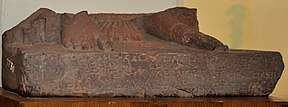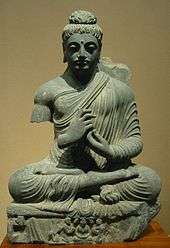Mahayana
Mahāyāna (/ˌmɑːhəˈjɑːnə/; Sanskrit: महायान, romanized: mahāyāna, "Great Vehicle") is one of the two main existing branches of Buddhism (the other being Theravada) and a term for classification of Buddhist philosophies and practice. This movement added a further set of discourses, and although it was initially very small in India, it had long-term historical significance.[1] The Buddhist tradition of Vajrayāna is sometimes classified as a part of Mahāyāna Buddhism, but some scholars consider it to be a different branch altogether.[2]
| Part of a series on |
| Mahāyāna Buddhism |
|---|
 |
|
Transmission |
|
Teachings
|
|
Mahāyāna sūtras |
| Part of a series on |
| Buddhism |
|---|
 |
|
|
|
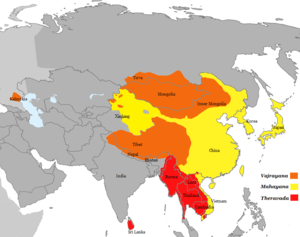
"Mahāyāna" also refers to the path of the Bodhisattva seeking complete enlightenment for the benefit of all sentient beings, also called "Bodhisattvayāna", or the "Bodhisattva Vehicle".[3][note 1] A bodhisattva who has accomplished this goal is called a samyaksaṃbuddha, or "fully enlightened Buddha". A samyaksaṃbuddha can establish the Dharma and lead disciples to enlightenment. Mahāyāna Buddhists teach that enlightenment can be attained in a single lifetime and this can be accomplished even by a layperson.[4]
The Mahāyāna tradition is the largest major tradition of Buddhism existing today, with 53% of practitioners, compared to 36% for Theravada and 6% for Vajrayana in 2010.[5]
In the course of its history, Mahāyāna Buddhism spread from India to various other South, East and Southeast Asian countries such as China, Taiwan, Mongolia, Korea, Japan, Vietnam, Indonesia, Malaysia, Nepal,Maldives, Sri Lanka Bhutan, and Singapore. Mahayana Buddhism also spread to other Central, West and Southeast Asian countries, such as Thailand, Cambodia, Laos, Burma, Afghanistan, Iran and other Central Asian countries before being replaced by Theravada Buddhism, Islam, or other religions.[6]
Large Mahāyāna scholastic centers such as Nalanda thrived during the latter period of Buddhism in India, between the seventh and twelfth centuries.[1] Major traditions of Mahāyāna Buddhism today include Chan Buddhism, Korean Seon, Japanese Zen, Pure Land Buddhism, Nichiren Buddhism and Vietnamese Buddhism. It may also include the Vajrayana traditions of Tiantai, Tendai, Shingon Buddhism, and Tibetan Buddhism, which add esoteric teachings to the Mahāyāna tradition.
Etymology
Original Sanskrit
According to Jan Nattier, the term Mahāyāna ("Great Vehicle") was originally an honorary synonym for Bodhisattvayāna ("Bodhisattva Vehicle"),[7] the vehicle of a bodhisattva seeking buddhahood for the benefit of all sentient beings.[3] The term Mahāyāna (which had earlier been used simply as an epithet for Buddhism itself) was therefore adopted at an early date as a synonym for the path and the teachings of the bodhisattvas. Since it was simply an honorary term for Bodhisattvayāna, the adoption of the term Mahāyāna and its application to Bodhisattvayāna did not represent a significant turning point in the development of a Mahāyāna tradition.[7]
The earliest Mahāyāna texts, such as the Lotus Sutra, often use the term Mahāyāna as a synonym for Bodhisattvayāna, but the term Hīnayāna is comparatively rare in the earliest sources. The presumed dichotomy between Mahāyāna and Hīnayāna can be deceptive, as the two terms were not actually formed in relation to one another in the same era.[8]
Among the earliest and most important references to Mahāyāna are those that occur in the Lotus Sūtra (Skt. Saddharma Puṇḍarīka Sūtra) dating between the 1st century BCE and the 1st century CE.[9] Seishi Karashima has suggested that the term first used in an earlier Gandhāri Prakrit version of the Lotus Sūtra was not the term mahāyāna but the Prakrit word mahājāna in the sense of mahājñāna (great knowing).[10][11] At a later stage when the early Prakrit word was converted into Sanskrit, this mahājāna, being phonetically ambivalent, was mistakenly converted into mahāyāna, possibly because of what may have been a double meaning in the famous Parable of the Burning House, which talks of three vehicles or carts (Skt: yāna).[note 2][10][12]
Chinese translation
In Chinese, Mahayana is called 大乘 (dasheng), which is a calque of maha (Great 大) yana (Vehicle 乘). There is also a transliteration 摩诃衍那.[13][14]
The term appeared in some of the earliest Mahayana texts, including Emperor Ling of Han's translation of the Lotus Sutra.[15] It has also appeared in Āgama. The terms 大乘 or even 小乘 do not appear in the Pāli Canon of the Theravada school.[16][17]
Some scholars think the definition is different from the common explanations of later generations.[18] When Buddhist scriptures were being translated into Chinese, Mahayana Buddhism already coexisted with other schools in India. Mahayana started to become popular with the rise of Han Buddhism.[19] According to comparisons with the Pali sutras, some scholars such as Yin Shun argue that the word 大乘 was added during translation into Chinese.[20]
History
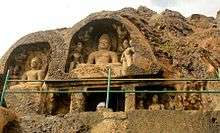
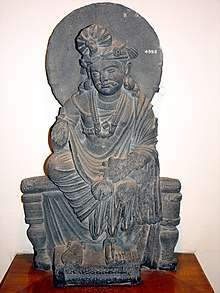
Origin theories
The origins of Mahāyāna are still not completely understood and there are numerous competing theories.[21] The earliest Western views of Mahāyāna assumed that it existed as a separate school in competition with the so-called "Hīnayāna" schools. According to David Drewes, for most of the 20th century, the leading theories about the origins of Mahāyāna were that it was either a lay movement (first argued by Jean Przyluski and supported by Etienne Lamotte and Akira Hirakawa) or that it developed among the Mahāsāṃghika Nikaya.[22] These theories have recently been mostly overturned or shown to be problematic.[22]
The earliest textual evidence of "Mahāyāna" comes from sūtras originating around the beginning of the common era. Jan Nattier has noted that some of the earliest Mahāyāna texts, such as the Ugraparipṛccha Sūtra use the term "Mahāyāna", yet there is no doctrinal difference between Mahāyāna in this context and the early schools, and that "Mahāyāna" referred rather to the rigorous emulation of Gautama Buddha in the path of a bodhisattva seeking to become a fully enlightened buddha.[15] Nattier writes that in the Ugra, Mahāyāna is not a school, but a rigorous and demanding "spiritual vocation, to be pursued within the existing Buddhist community."[23]
Several scholars such as Hendrik Kern and A.K. Warder suggested that Mahāyāna and its sutras (such as the very first versions of the Prajñāpāramitā genre) developed among the Mahāsāṃghika Nikaya (from the 1st century BCE onwards), some pointing to the area along the Kṛṣṇa River in the Āndhra region of southern India as a geographical origin.[24][25][22][26][27] Paul Williams thinks that "there can be no doubt that at least some early Mahāyāna sutras originated in Mahāsāṃghika circles", pointing to the Mahāsāṃghika doctrine of the supramundane (lokottara) nature of the Buddha, which is very close to the Mahāyāna view of the Buddha.[28]
Anthony Barber and Sree Padma note that "historians of Buddhist thought have been aware for quite some time that such pivotally important Mahayana Buddhist thinkers as Nāgārjuna, Dignaga, Candrakīrti, Āryadeva, and Bhavaviveka, among many others, formulated their theories while living in Buddhist communities in Āndhra."[29] However, more recently Seishi Karashima has argued for their origin in the Gandhara region.[30] Some scholars such as Warder think that after a period of composition in the south, later the activity of writing additional scriptures moved to the north.[note 3] Joseph Walser also notes that certain other sutras "betray a northwestern origin" and mention products of trade with China (or obtained outside of India, such as silk or coral).[31]
Important pieces of evidence for the early Mahāyāna include the texts translated by the monk Lokakṣema in the 2nd century CE, who came to China from the kingdom of Gandhāra. These are some of the earliest known Mahāyāna texts.[32][33][note 4] Study of these texts by Paul Harrison and others show that they strongly promote monasticism (contra the lay origin theory), acknowledge the legitimacy of arhatship, do not recommend devotion towards 'celestial' bodhisattvas and do not show any attempt to establish a new sect or order.[22] Some of these texts often emphasize ascetic practices, forest dwelling, and deep states of meditative concentration (samadhi).[34] Some scholars further speculate that the prajñāpāramitā sūtras were written in response to certain theories of the abhidharma schools.[35]
Evidence from sutras which depict a close connection of Mahāyāna with monasticism eventually revealed the problems with the lay origins theory.[22] The Mahāsāṃghika origins theory has also slowly been shown to be problematic by scholarship that revealed how certain Mahāyāna sutras show traces of having developed among other nikāyas or monastic orders (such as the Dharmaguptaka).[36] Because of such evidence, scholars like Paul Harrison and Paul Williams argue that the movement was not sectarian and possibly pan-buddhist.[22][37] There is no evidence that Mahāyāna ever referred to a separate formal school or sect of Buddhism, but rather that it existed as a certain set of ideals, and later doctrines, for aspiring bodhisattvas.[15] Paul Williams has also noted that Mahāyāna never had nor ever attempted to have a separate Vinaya or ordination lineage from the early schools of Buddhism, and therefore each bhikṣu or bhikṣuṇī adhering to the Mahāyāna formally belonged to an early school. Membership in these nikāyas, or monastic sects, continues today with the Dharmaguptaka nikāya in East Asia, and the Mūlasarvāstivāda nikāya in Tibetan Buddhism. Therefore, Mahāyāna was never a separate rival sect of the early schools.[38] Paul Harrison clarifies that while monastic Mahāyānists belonged to a nikāya, not all members of a nikāya were Mahāyānists.[39] From Chinese monks visiting India, we now know that both Mahāyāna and non-Mahāyāna monks in India often lived in the same monasteries side by side.[40] It is also possible that, formally, Mahāyāna would have been understood as a group of monks or nuns within a larger monastery taking a vow together (known as a "kriyākarma") to memorize and study a Mahāyāna text or texts.[41]
Gregory Schopen meanwhile has argued that a series of loosely connected movements developed during the 2nd century around cult shrines where Mahāyāna sutras were kept, and the "cult of the book" theory is also popular among other current scholars.[22]
After examining the epigraphic evidence, Schopen also argues that Mahāyāna remained "an extremely limited minority movement – if it remained at all – that attracted absolutely no documented public or popular support for at least two more centuries."[22] Schopen also sees this movement as being in tension with other Buddhists, "struggling for recognition and acceptance".[42] Their "embattled mentality" may have led to certain elements found in Mahāyāna texts such as the Lotus sutra.[42]
Likewise, Joseph Walser speaks of Mahāyāna's "virtual invisibility in the archaeological record until the fifth century."[43] Schopen, Harrison and Nattier also argue that these communities were probably not a single unified movement, but scattered groups based on different practices and sutras.[22] One reason for this view is that Mahāyāna sources are extremely diverse, advocating many different, often conflicting doctrines and positions, as Jan Nattier writes:[44]
Thus we find one scripture (the Aksobhyavyuha) that advocates both srávaka and bodhisattva practices, propounds the possibility of rebirth in a pure land, and enthusiastically recommends the cult of the book, yet seems to know nothing of emptiness theory, the ten bhumis, or the trikaya, while another (the P’u-sa pen-yeh ching) propounds the ten bhumis and focuses exclusively on the path of the bodhisattva, but never discusses the paramitas. A Madhyamika treatise (Nagarjuna’s Mulamadhyamika-karikas) may enthusiastically deploy the rhetoric of emptiness without ever mentioning the bodhisattva path, while a Yogacara treatise (Vasubandhu’s Madhyanta-vibhaga-bhasya) may delve into the particulars of the trikaya doctrine while eschewing the doctrine of ekayana. We must be prepared, in other words, to encounter a multiplicity of Mahayanas flourishing even in India, not to mention those that developed in East Asia and Tibet.
One of the current leading theories is what Paul Harrison calls "the forest hypothesis" and defines as:
‘the Mahāyāna … was the work of hard-core ascetics, members of the forest dwelling (aranyavasin) wing of the Buddhist Order’[45]
Some scholars point to how some of the earliest Mahāyāna texts often depict strict adherence to the path of a bodhisattva, and engagement in the ascetic ideal of a monastic life in the wilderness, akin to the ideas expressed in the Rhinoceros Sūtra.[note 5] Reginald Ray has also defended this view in his Buddhist Saints in India (1994). Likewise, Jan Nattier's study of the Ugraparipṛccha Sūtra, A few good men (2003) argues that this sutra represents the earliest form of Mahāyāna, which presents the bodhisattva path as a ‘supremely difficult enterprise’ of elite monastic forest asceticism.[22] Boucher's study on the Rāṣṭrapālaparipṛcchā-sūtra (2008) is another recent work on this subject.[46]
David Drewes argues against both the book cult hypothesis and the forest hypothesis. He points out that there is no actual evidence for existence of book shrines, that the practice of sutra veneration was pan-buddhist and not distinctly Mahāyāna, and that "Mahāyāna sutras advocate mnemic ⁄ oral ⁄ aural practices more frequently than they do written ones."[22] Regarding the forest hypothesis, he points out that only two of the 12 or so texts of the Lokakṣema corpus directly advocate forest dwelling, while the others either do not mention it or see it as unhelpful, promoting easier practices such as "merely listening to the sutra, or thinking of particular Buddhas, that they claim can enable one to be reborn in special, luxurious ‘pure lands’ where one will be able to make easy and rapid progress on the bodhisattva path and attain Buddhahood after as little as one lifetime."[22] Drewes states that the evidence merely shows that "Mahāyāna was primarily a textual movement, focused on the revelation, preaching, and dissemination of Mahāyāna sutras, that developed within, and never really departed from, traditional Buddhist social and institutional structures."[47] Drewes points out the importance of dharmabhanakas (preachers, reciters of these sutras) in the early Mahāyāna sutras. This figure is widely praised as someone who should be respected, obeyed ('as a slave serves his lord'), and donated to, and it is thus possible these people were the primary agents of the Mahāyāna movement.[47]
Earliest inscriptions
"Bu-ddha-sya A-mi-tā-bha-sya"
"Of the Buddha Amitabha"[49]
The earliest stone inscription containing a recognizably Mahāyāna formulation and a mention of the Buddha Amitābha was found in the Indian subcontinent in Mathura, and dated to around 180 CE. Remains of a statue of a Buddha bear the Brāhmī inscription: "Made in the year 28 of the reign of King Huviṣka, ... for the Blessed One, the Buddha Amitābha."[49] There is also some evidence that Emperor Huviṣka himself was a follower of Mahāyāna Buddhism, and a Sanskrit manuscript fragment in the Schøyen Collection describes Huviṣka as having "set forth in the Mahāyāna."[50] Evidence of the name "Mahāyāna" in Indian inscriptions in the period before the 5th century is very limited in comparison to the multiplicity of Mahāyāna writings transmitted from Central Asia to China at that time.[note 6][note 7][note 8]
Growth
The Mahāyāna movement (or movements) remained quite small until it became established in the fifth century, with very few manuscripts having been found before then (the exceptions are from Bamiyan). According to Walser, "the fifth and sixth centuries appear to have been a watershed for the production of Mahāyāna manuscripts."[51] Likewise it is only in the 4th and 5th centuries CE that epigraphic evidence shows some kind of popular support for Mahāyāna, including some possible royal support at the kingdom of Shan shan as well as in Bamiyan and Mathura.[52] Still, even after the 5th century, the epigraphic evidence which use the term Mahāyāna is still quite small and is notably mainly monastic, not lay.[52] By this time, Chinese pilgrims, such as Faxian, Yijing, and Xuanzang were traveling to India, and their writings do describe monasteries which they label 'Mahāyāna' as well as monasteries where both Mahāyāna monks and non-Mahāyāna monks lived together.[53]
After the fifth century, Mahāyāna Buddhism and its institutions slowly grew in influence. Some of the most influential institutions became massive monastic university complexes such as Nalanda (established by the 5th-century CE Gupta emperor, Kumaragupta I) and Vikramashila (established under Dharmapala c. 783 to 820) which were centers of various branches of scholarship, including Mahāyāna philosophy. The Nalanda complex eventually became the largest and most influential Buddhist center in India for centuries.[54] Even so, as noted by Paul Williams, "it seems that fewer than 50 per cent of the monks encountered by Xuanzang (Hsüan-tsang; c. 600–664) on his visit to India actually were Mahāyānists."[55]
Indian Mahāyāna developed various schools of thought, some groupings include: Mādhyamaka, Yogācāra, Buddha-nature (Tathāgatagarbha), and Buddhist logic as the last and most recent.[56] Over time Indian Mahāyāna texts and philosophy reached Central Asia and China through trade routes, afterwards spreading throughout East Asia. In some cases Indian philosophical traditions were directly transplanted, as with the case of the East Asian Madhymaka and East Asian Yogacara schools. Later, new developments in Chinese Mahāyāna led to new Chinese schools like Tiantai, Huayen and Chan Buddhism (Zen).
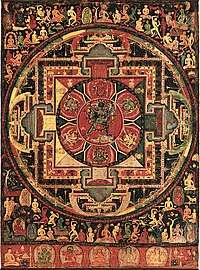
Forms of Mahāyāna based on the doctrines of the Prajñāpāramitā sutras, Buddha Nature sutras, Lotus sutra and the Pure Land teachings are still popular in East Asian Buddhism, which is completely dominated by branches of Mahāyāna. Paul Williams has noted that in this tradition in the Far East, primacy has always been given to study of the Mahāyāna sūtras.[57]
Later developments
Under the Gupta and Pala empires, a new movement began to develop which drew on previous Mahāyāna doctrine as well as new ideas and which came to be known by various names such as Vajrayāna, Mantrayāna, and Tantric Buddhism. Possibly led by groups of wandering tantric yogis named mahasiddhas, this movement developed new tantric spiritual practices and also promoted new texts called the Buddhist Tantras.[58] This new form of Buddhism eventually also spread north to Tibet and east to China.
Various classes of Vajrayana literature developed as a result of royal courts sponsoring both Buddhism and Saivism.[59] The Mañjusrimulakalpa, which later came to classified under Kriyatantra, states that mantras taught in the Shaiva, Garuda and Vaishnava tantras will be effective if applied by Buddhists since they were all taught originally by Manjushri.[60] The Guhyasiddhi of Padmavajra, a work associated with the Guhyasamaja tradition, prescribes acting as a Shaiva guru and initiating members into Saiva Siddhanta scriptures and mandalas.[61] The Samvara tantra texts adopted the pitha list from the Shaiva text Tantrasadbhava, introducing a copying error where a deity was mistaken for a place.[62]
Doctrine
Few things can be said with certainty about Mahāyāna Buddhism,[note 9] especially its early Indian form, other than that the Buddhism practiced in China, Indonesia, Vietnam, Korea, Tibet, and Japan is Mahāyāna Buddhism.[note 10] Mahāyāna can be described as a loosely bound collection of many teachings with large and expansive doctrines that are able to exist simultaneously.[note 11]
Mahāyāna constitutes an inclusive set of traditions characterized by plurality and the adoption of new Mahāyāna sutras in addition to the earlier āgamas. Mahāyāna sees itself as penetrating further and more profoundly into the Buddha's Dharma. An Indian commentary on the Mahāyānasaṃgraha, entitled Vivṛtaguhyārthapiṇḍavyākhyā, gives a classification of teachings according to the capabilities of the audience:[63]
[A]ccording to disciples' grades, the Dharma is [classified as] inferior and superior. For example, the inferior was taught to the merchants Trapuṣa and Ballika because they were ordinary men; the middle was taught to the group of five because they were at the stage of saints; the eightfold Prajñāpāramitās were taught to bodhisattvas, and [the Prajñāpāramitās] are superior in eliminating conceptually imagined forms.
There is also a tendency in Mahāyāna sūtras to regard adherence to these sūtras as generating spiritual benefits greater than those that arise from being a follower of the non-Mahāyāna approaches to Dharma. Thus the Śrīmālādevī Siṃhanāda Sūtra claims that the Buddha said that devotion to Mahāyāna is inherently superior in its virtues to following the śrāvaka or pratyekabuddha paths.[64]
Buddhas and bodhisattvas
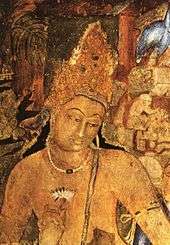
Buddhas and bodhisattvas are central elements of Mahāyāna. Mahāyāna has a vastly expanded cosmology, with various Buddhas and bodhisattvas residing in different worlds and buddha-fields (buddha ksetra). An important feature of Mahāyāna is the way that it understands the nature of a Buddha, which differs from non-Mahāyāna understandings. Mahāyāna texts not only often depict numerous Buddhas besides Sakyamuni, but see them as transcendental or supramundane (lokuttara) beings.[28] According to Paul Williams, for the Mahāyāna, a Buddha is often seen as "a spiritual king, relating to and caring for the world", rather than simply a teacher who after his death "has completely ‘gone beyond’ the world and its cares".[65] Buddha Sakyamuni's life and death on earth is then usually understood as a "mere appearance", his death is a show, while in actuality he remains out of compassion to help all sentient beings.[65]
Dr. Guang Xing describes the Mahāyāna Buddha as "an omnipotent divinity endowed with numerous supernatural attributes and qualities ...[He] is described almost as an omnipotent and almighty godhead."[66] The concept of the three bodies (trikāya) of the Buddha was developed to make sense of these ideas, with nirmanakaya Buddhas (like Sakyamuni) being seen as an emanation from the Dharmakaya. Through the use of various practices, a Mahāyāna devotee can aspire to be reborn in a Buddha's pure land or buddhafield, where they can strive towards buddhahood in the best possible conditions. Depending on the sect, liberation into a buddha-field can be obtained by faith, meditation, or sometimes even by the repetition of Buddha's name. Faith based devotional practices focused on rebirth in pure lands are common in East Asian Pure Land Buddhism.[67]
Mahāyāna generally holds that pursuing only the personal release from suffering i.e. nirvāṇa is a narrow or inferior aspiration, because it lacks the resolve to liberate all other sentient beings from saṃsāra (the round of rebirth) by becoming a Buddha. One who engages in this path to complete buddhahood is called a bodhisattva. High level bodhisattvas are also seen as extremely powerful supramundane beings. Popular bodhisattvas include Avalokiteshvara, Manjushri and Maitreya. Bodhisattvas could reach the personal nirvana of the arhats, but they believe it is more important to remain in saṃsāra and help others.[68][69] There are two models for this which are seen in the various Mahāyāna texts, one is the idea that a bodhisattva must postpone their awakening until Buddhahood is attained. This could take aeons and in the meantime they will be helping countless beings. After reaching Buddhahood, they do pass on to cessation (nirvāṇa) just like an arhat. The second model is the idea that there are two kinds of nirvāṇa, the nirvāṇa of an arhat and a superior type of nirvāṇa called apratiṣṭhita (non-abiding) that allows a Buddha to remain forever engaged in the world. As noted by Paul Williams, the idea of apratiṣṭhita nirvāṇa may have taken some time to develop and is not obvious in some of the early Mahāyāna literature.[69]
The Bodhisattva path
.jpg)
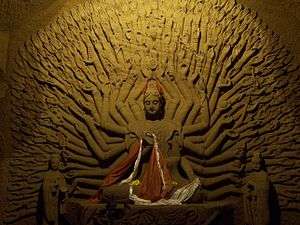
The Mahāyāna bodhisattva path (mārga) or vehicle (yāna) is seen as being the superior spiritual path by Mahāyānists, over and above the paths of those who seek arhatship or "solitary buddhahood" for their own sake (Śrāvakayāna and Pratyekabuddhayāna). According to eighth century Mahāyāna philosopher Haribhadra, the term "bodhisattva" can refer to those who follow any of the three vehicles, since all are working towards bodhi (awakening) and hence the technical term for a Mahāyāna bodhisattva is a mahāsattva (great being) bodhisattva.[70] According to Paul Williams, a Mahāyāna bodhisattva is best defined as:
that being who has taken the vow to be reborn, no matter how many times this may be necessary, in order to attain the highest possible goal, that of Complete and Perfect Buddhahood. This is for the benefit of all sentient beings.[70]
Taking the bodhisattva vow to "lead to Nirvana the whole immeasurable world of beings" as the prajñaparamita sutras state, is the central characteristic of the bodhisattva.[71] According to the Bodhipathapradīpa (A Lamp for the Path to Awakening) by the Indian master Atiśa, the central defining feature of a bodhisattva's path is the universal aspiration to end suffering for themselves and all other beings. The spiritual motivation is termed bodhicitta ("the mind of awakening").[72]
Another key virtue of a bodhisattva is their "great compassion" (maha-karuṇā) which leads one to work tirelessly for the ultimate good of all beings. This universal compassion is foundational for a bodhisattva and leads to bodhicitta. According to the Indian philosopher Shantideva, when great compassion and bodhicitta arises in a person's heart, they cease to be an ordinary person and become a "son or daughter of the Buddhas".[72] Another foundational bodhisattva virtue is prajñā (transcendent knowledge or wisdom) which is an understanding of the emptiness of things arising from study, deep consideration and meditation.[71]
Numerous sutras hold that a key part of the bodhisattva path is the practice of a set of virtues called pāramitās (transcendent or supreme virtues). Sometimes six are outlined:[73]
- dāna-pāramitā: the perfection of giving
- śīla-pāramitā: the perfection of moral conduct or discipline
- kṣānti-pāramitā: the perfection of patient endurance
- vīrya-pāramitā: the perfection of vigor or diligence
- dhyāna-pāramitā: the perfection of meditation
- prajñā-pāramitā: the perfection of transcendent wisdom.
Other sutras such as the Daśabhūmika Sūtra give a list of ten, with the addition of upāya (skillful means), praṇidhāna (vow, resolution), Bala (spiritual power) and Jñāna (knowledge).[74]
Various texts associate the beginning of the bodhisattva practice with what is called the path of accumulation or equipment (saṃbhāra-mārga), which is the first path of the five paths schema which possibly developed from Sarvastivada sources.[75] The Daśabhūmika Sūtra as well as other texts also outline a series bodhisattva levels or spiritual stages (bhūmis ) on the path. The various texts disagree on the number of stages however, the Daśabhūmika giving ten for example (and mapping each one to the ten paramitas), the Bodhisattvabhūmi giving seven and thirteen and the Avatamsaka outlining 40 stages.[74] In later Mahāyāna scholasticism, such as in the work of Kamalashila and Atiśa, the five paths and ten bhūmi systems are merged and this is the progressive path model that is used in Tibetan Buddhism. According Paul Williams, in these systems, the first bhūmi is reached once one attains "direct, nonconceptual and nondual insight into emptiness in meditative absorption", which is associated with the path of seeing (darśana-mārga).[75]
Expedient means
Expedient means[76] (Skt. upāya) is another important skill of the Mahāyāna bodhisattva. The idea is most famously expounded in the Lotus Sutra, one of the earliest-dated sutras, and is accepted in all Mahāyāna schools of thought. It is any effective method or technique that aids awakening. It does not necessarily mean that some particular method is "untrue" but is simply any means or stratagem that is conducive to spiritual growth and leads beings to awakening and nirvana. Expedient means could thus be certain motivational words for a particular listener or even the Noble Eightfold Path itself. Basic Buddhism (what Mahāyāna would term śrāvakayāna or pratyekabuddhayāna) is an expedient method for helping people begin the noble Buddhist path and advance quite far. But the path is not wholly traversed, according to some schools, until the practitioner has striven for and attained Buddhahood for the liberation of all other sentient beings from suffering.[77]
Some scholars have stated that the exercise of expedient means, "the ability to adapt one's message to the audience, is also of enormous importance in the Pāli canon."[note 12] In fact the Pāli term upāya-kosalla does occur in the Pāli Canon, in the Sangiti Sutta of the Digha Nikāya.[78]
Major philosophical ideas
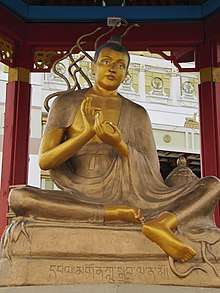
Śūnyavāda
A central doctrine discussed by numerous Mahāyāna texts is the theory of emptiness or voidness (śūnyatā). It is considered to be an essential doctrine of the prajñāpāramitā genre of sutras as well as the core teaching of the Madhyamaka philosophy. This theory amounts to the idea that all phenomena (dharmas) without exception have "no essential unchanging core", and therefore have "no fundamentally real existence."[80] Because of this, all things, even the Dharma, the Buddha and all beings, are like “illusions” (māyā) and “dreams” (svapna).[81] Obtaining a deep understanding of this is said to be the prajñāpāramitā, the perfection of wisdom.
The Mahāyāna philosophical school termed Madhyamaka (Middle theory or Centrism, also known as śūnyavāda, 'the emptiness theory'), which was founded by the second century figure of Nagarjuna focuses on refuting all theories which posit any kind of substance, inherent existence or intrinsic nature (svabhāva).[82] Nagarjuna attempts to show in his works that any theory of intrinsic nature is contradicted by the Buddha's theory of dependent origination, since anything that has an independent existence cannot be dependently originated. The śūnyavāda philosophers were adamant that their denial of svabhāva is not a kind of nihilism (against protestations to the contrary by their opponents). Using the two truths theory they claimed that while one can speak of things existing in a conventional, relative sense, they do not exist inherently in an ultimate sense. They also argued that emptiness itself is also "empty", it does not have an absolute inherent existence nor does it mean a transcendental absolute reality, but is merely a useful concept or abstraction. In fact, since everything is empty of true existence, all things are just conceptualizations (prajñapti-matra), including the theory of emptiness, and all concepts must ultimately be abandoned in order to truly understand the nature of things.[83]
Vijñānavāda
Vijñānavāda ("the doctrine of consciousness", a.k.a. vijñapti-mātra, "perceptions only" and citta-mātra "mind only") is another important doctrine promoted by some Mahāyāna sutras and later became the central theory of a major philosophical movement which arose during the Gupta period called Yogācāra. The primary sutra associated with this school of thought is the Saṃdhinirmocana Sūtra, which claims that śūnyavāda is not the final definitive teaching (nītārtha) of the Buddha. Instead, the ultimate truth (paramārtha-satya) is said to be the view that all things (dharmas) are only mind (citta), consciousness (vijñāna) or perceptions (vijñapti) and that seemingly "external" objects (or "internal" subjects) do not really exist apart from the dependently originated flow of mental experiences. When this flow of mentality is seen as being empty of the subject-object duality we impose upon it, one reaches the non-dual cognition of "Thusness" (tathatā), which is nirvana. This doctrine is developed through various theories, the most important being the eight consciousnesses and the three natures.[84] The Saṃdhinirmocana calls its doctrine the 'third turning of the dharma wheel'. The Pratyutpanna sutra also mentions this doctrine, stating: "whatever belongs to this triple world is nothing but thought [citta-mātra]. Why is that? It is because however I imagine things, that is how they appear".[84]
The most influential thinkers in this tradition were the Indian brothers Asanga and Vasubandhu, along with an obscure figure termed Maitreyanātha. Yogācāra philosophers developed their own interpretation of the doctrine of emptiness which also criticized Madhyamaka for falling into nihilism.[85]
Tathāgatagarbha
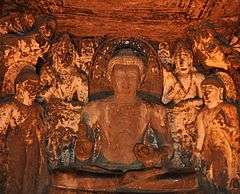
The doctrine of Tathāgata store or Tathāgata womb (Tathāgatagarbha), also known as Buddha-nature or Buddha Principle (Skt: Buddha-dhātu) is important in all modern Mahāyāna traditions, though interpreted in different ways. Broadly speaking Buddha-nature is concerned with ascertaining what allows sentient beings to become Buddhas.[86] The term may have first appeared in the Mahāyāna Mahāparinirvāṇa Sūtra,[87] where it refers to "a sacred nature that is the basis for [beings'] becoming buddhas",[88] and where it is also spoken of as the 'Self' (atman).[89] The doctrine of a "really existing permanent element" within all sentient beings is a source of much debate and disagreement among Mahāyāna Buddhist philosophers as well as modern academics.[90] Some scholars have seen this as an influence from Brahmanic Hinduism, while some of these sutras admit that the use of the term 'Self' is partly done in order to win over non-Buddhist ascetics.[91][92]
According to some scholars, the Buddha nature discussed in some Mahāyāna sūtras does not represent a substantial self (ātman); rather, it is a positive language and expression of emptiness (śūnyatā) and represents the potentiality to realize Buddhahood through Buddhist practices.[93] Other Mahāyāna philosophies like Madhyamaka were mainly dominated by a discourse of emptiness, which used primarily negative or apophatic language. The Buddha nature genre of sūtras can be seen as an attempt to state Buddhist teachings using positive language while also maintaining the middle way, to prevent people from being turned away from Buddhism by a false impression of nihilism.[94] A different view is propounded by Tathāgatagarbha specialist, Michael Zimmermann, who sees key Buddha-nature sutras such as the Nirvana Sutra and the Tathagatagarbha Sutra as teaching an affirmative vision of an eternal, indestructible Buddhic Self.[89]
The Uttaratantra (an exegetical treatise on Buddha nature) sees Buddha nature as eternal, uncaused, unconditioned, and incapable of being destroyed, although temporarily concealed within worldly beings by adventitious defilements.[95] According to C. D. Sebastian, the Uttaratantra's reference to a transcendental self (ātma-pāramitā) should be understood as "the unique essence of the universe",[96] thus the universal and immanent essence of Buddha nature is the same throughout time and space.[97]
Scripture
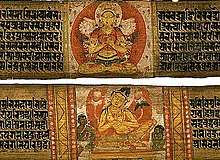
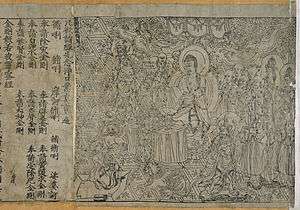
Mahāyāna Buddhism takes the basic teachings of the Buddha as recorded in early scriptures as the starting point of its teachings, such as those concerning karma and rebirth, anātman, emptiness, dependent origination, and the Four Noble Truths. Mahāyāna Buddhists in East Asia have traditionally studied these teachings in the Āgamas preserved in the Chinese Buddhist canon. "Āgama" is the term used by those traditional Buddhist schools in India who employed Sanskrit for their basic canon. These correspond to the Nikāyas used by the Theravāda school. The surviving Āgamas in Chinese translation belong to at least two schools. Most of the Āgamas were never translated into the Tibetan canon, which according to Hirakawa, only contains a few translations of early sutras corresponding to the Nikāyas or Āgamas.[98] However, these basic doctrines are contained in Tibetan translations of later works such as the Abhidharmakośa and the Yogācārabhūmi-Śāstra.
Mahāyāna sutras
In addition to accepting the essential scriptures of the early Buddhist schools as valid, Mahāyāna Buddhism maintains large collections of sūtras that are not recognized as authentic by the modern Theravāda school. The earliest of these sutras do not call themselves ‘Mahāyāna,’ but use the terms vaipulya (extensive) sutras, or gambhira (profound) sutras.[47] These were also not recognized by some individuals in the early Buddhist schools. In other cases, Buddhist communities such as the Mahāsāṃghika school were divided along these doctrinal lines.[99] In Mahāyāna Buddhism, the Mahāyāna sūtras are often given greater authority than the Āgamas. The first of these Mahāyāna-specific writings were written probably around the 1st century BCE or 1st century CE.[100][101] Some influential Mahāyāna sutras are the Prajñaparamita sutras, the Lotus Sutra, the Pure Land sutras, the Vimalakirti Sutra, the Golden Light Sutra, the Avatamsaka Sutra, the Sandhinirmocana Sutra and the Tathāgatagarbha sūtras.
According to David Drewes, Mahāyāna sutras contain several elements besides the promotion of the bodhisattva ideal, including "expanded cosmologies and mythical histories, ideas of purelands and great, ‘celestial’ Buddhas and bodhisattvas, descriptions of powerful new religious practices, new ideas on the nature of the Buddha, and a range of new philosophical perspectives."[47] These texts present stories of revelation in which the Buddha teaches Mahāyāna sutras to certain bodhisattvas who vow to teach and spread these sutras after the Buddha's death.[47] Regarding religious praxis, David Drewes outlines the most commonly promoted practices in Mahāyāna sutras were seen as means to achieve Buddhahood quickly and easily and included "hearing the names of certain Buddhas or bodhisattvas, maintaining Buddhist precepts, and listening to, memorizing, and copying sutras, that they claim can enable rebirth in the pure lands Abhirati and Sukhavati, where it is said to be possible to easily acquire the merit and knowledge necessary to become a Buddha in as little as one lifetime."[47] Another widely recommended practice is anumodana, or rejoicing in the good deeds of Buddhas and Bodhisattvas.
The practice of meditation and visualization of Buddhas has been seen by some scholars as a possible explanation for the source of certain Mahāyāna sutras which are seen traditionally as direct visionary revelations from the Buddhas in their pure lands. Paul Harrison has also noted the importance of dream revelations in certain Mahāyāna sutras such as the Arya-svapna-nirdesa which lists and interprets 108 dream signs.[102]
As noted by Paul Williams, one feature of Mahāyāna sutras (especially earlier ones) is "the phenomenon of laudatory self reference – the lengthy praise of the sutra itself, the immense merits to be obtained from treating even a verse of it with reverence, and the nasty penalties which will accrue in accordance with karma to those who denigrate the scripture."[103] Some Mahāyāna sutras also warn against the accusation that they are not the word of the Buddha (buddhavacana), such as the Astasāhasrikā (8,000 verse) Prajñāpāramitā, which states that such claims come from Mara (the evil tempter).[104] Some of these Mahāyāna sutras also warn those who would denigrate Mahāyāna sutras or those who preach it (i.e. the dharmabhanaka) that this action can lead to rebirth in hell.[105]
Another feature of some Mahāyāna sutras, especially later ones, is increasing sectarianism and animosity towards non-Mahāyāna practitioners (sometimes called sravakas, "hearers") which are sometimes depicted as being part of the 'hīnayāna' (the 'inferior way') who refuse to accept the 'superior way' of the Mahāyāna.[106][107] As noted by Paul Williams, earlier Mahāyāna sutras like the Ugraparipṛcchā Sūtra and the Ajitasena sutra do not present any antagonism towards the hearers or the ideal of arhatship like later sutras do.[107] Regarding the bodhisattva path, some Mahāyāna sutras promote it as a universal path for everyone, while others like the Ugraparipṛcchā see it as something for a small elite of hardcore ascetics.[107]
In the 4th century Mahāyāna abhidharma work Abhidharmasamuccaya, Asaṅga refers to the collection which contains the āgamas as the Śrāvakapiṭaka and associates it with the śrāvakas and pratyekabuddhas.[108] Asaṅga classifies the Mahāyāna sūtras as belonging to the Bodhisattvapiṭaka, which is designated as the collection of teachings for bodhisattvas.[108]
Other literature
Mahāyāna Buddhism also developed a massive commentarial and exegetical literature, many of which are called śāstra (treatises) or vrittis (commentaries). Philosophical texts were also written in verse form (karikās), such as in the case of the famous Mūlamadhyamika-karikā (Root Verses on the Middle Way) by Nagarjuna, the foundational text of Madhyamika philosophy. Numerous later Madhyamika philosophers like Candrakirti wrote commentaries on this work as well as their own verse works.
Mahāyāna Buddhist tradition also relies on numerous non-Mahayana commentaries (śāstra), a very influential one being the Abhidharmakosha of Vasubandhu, which is written from a non-Mahayana Sarvastivada–Sautrantika perspective.
Vasubandhu is also the author of various Mahāyāna Yogacara texts on the philosophical theory known as vijñapti-matra (conscious construction only). The Yogacara school philosopher Asanga is also credited with numerous highly influential commentaries. In East Asia, the Satyasiddhi śāstra was also influential.
Another influential tradition is that of Dignāga's Buddhist logic whose work focused on epistemology. He produced the Pramānasamuccaya, and later Dharmakirti wrote the Pramānavārttikā, which was a commentary and reworking of the Dignaga text.
Later Tibetan and Chinese Buddhists continued the tradition of writing commentaries.
Classifications
Dating back at least to the Saṃdhinirmocana Sūtra is a classification of the corpus of Buddhism into three categories, based on ways of understanding the nature of reality, known as the "Three Turnings of the Dharma Wheel". According to this view, there were three such "turnings":[109]
- In the first turning, the Buddha taught the Four Noble Truths at Varanasi for those in the śravaka vehicle. It is described as marvelous and wonderful, but requiring interpretation and occasioning controversy.[110] The doctrines of the first turning are exemplified in the Dharmacakra Pravartana Sūtra. This turning represents the earliest phase of the Buddhist teachings and the earliest period in the history of Buddhism.
- In the second turning, the Buddha taught the Mahāyāna teachings to the bodhisattvas, teaching that all phenomena have no-essence, no arising, no passing away, are originally quiescent, and essentially in cessation. This turning is also described as marvelous and wonderful, but requiring interpretation and occasioning controversy.[110] Doctrine of the second turning is established in the Prajñāpāramitā teachings, first put into writing around 100 BCE. In Indian philosophical schools, it is exemplified by the Mādhyamaka school of Nāgārjuna.
- In the third turning, the Buddha taught similar teachings to the second turning, but for everyone in the three vehicles, including all the śravakas, pratyekabuddhas, and bodhisattvas. These were meant to be completely explicit teachings in their entire detail, for which interpretations would not be necessary, and controversy would not occur.[110] These teachings were established by the Saṃdhinirmocana Sūtra as early as the 1st or 2nd century CE.[111] In the Indian philosophical schools, the third turning is exemplified by the Yogācāra school of Asaṅga and Vasubandhu.
Some traditions of Tibetan Buddhism consider the teachings of Esoteric Buddhism and Vajrayāna to be the third turning of the Dharma Wheel.[112] Tibetan teachers, particularly of the Gelugpa school, regard the second turning as the highest teaching, because of their particular interpretation of Yogācāra doctrine. The Buddha Nature teachings are normally included in the third turning of the wheel.
The different Chinese Buddhist traditions have different schemes of doctrinal periodization called panjiao which they use to organize the sometimes bewildering array of texts.
Relationship with the early texts
Scholars have noted that many key Mahāyāna ideas are closely connected to the earliest texts of Buddhism. The seminal work of Mahāyāna philosophy, Nāgārjuna's Mūlamadhyamakakārikā, mentions the canon's Katyāyana Sūtra (SA 301) by name, and may be an extended commentary on that work.[113] Nāgārjuna systematized the Mādhyamaka school of Mahāyāna philosophy. He may have arrived at his positions from a desire to achieve a consistent exegesis of the Buddha's doctrine as recorded in the canon. In his eyes the Buddha was not merely a forerunner, but the very founder of the Mādhyamaka system.[114] Nāgārjuna also referred to a passage in the canon regarding "nirvanic consciousness" in two different works.[115]
Yogācāra, the other prominent Mahāyāna school in dialectic with the Mādhyamaka school, gave a special significance to the canon's Lesser Discourse on Emptiness (MA 190).[116] A passage there (which the discourse itself emphasizes) is often quoted in later Yogācāra texts as a true definition of emptiness.[117] According to Walpola Rahula, the thought presented in the Yogācāra school's Abhidharma-samuccaya is undeniably closer to that of the Pali Nikayas than is that of the Theravadin Abhidhamma.[118]
Both the Mādhyamikas and the Yogācārins saw themselves as preserving the Buddhist Middle Way between the extremes of nihilism (everything as unreal) and substantialism (substantial entities existing). The Yogācārins criticized the Mādhyamikas for tending towards nihilism, while the Mādhyamikas criticized the Yogācārins for tending towards substantialism.[119]
Key Mahāyāna texts introducing the concepts of bodhicitta and Buddha nature also use language parallel to passages in the canon containing the Buddha's description of "luminous mind" and appear to have evolved from this idea.[120][121]
Theravāda school
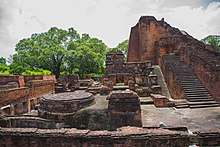
Role of the Bodhisattva
In the early Buddhist texts, and as taught by the modern Theravada school, the goal of becoming a teaching Buddha in a future life is viewed as the aim of a small group of individuals striving to benefit future generations after the current Buddha's teachings have been lost, but in the current age there is no need for most practitioners to aspire to this goal. Theravada texts do, however, hold that this is a more perfectly virtuous goal.[122]
Paul Williams writes that some modern Theravada meditation masters in Thailand are popularly regarded as bodhisattvas.[123]
Cholvijarn observes that prominent figures associated with the Self perspective in Thailand have often been famous outside scholarly circles as well, among the wider populace, as Buddhist meditation masters and sources of miracles and sacred amulets. Like perhaps some of the early Mahāyāna forest hermit monks, or the later Buddhist Tantrics, they have become people of power through their meditative achievements. They are widely revered, worshipped, and held to be arhats or (note!) bodhisattvas.
Theravāda and Hīnayāna
In the 7th century, the Chinese Buddhist monk Xuanzang describes the concurrent existence of the Mahāvihara and the Abhayagiri Vihara in Sri Lanka. He refers to the monks of the Mahāvihara as the "Hīnayāna Sthaviras" (Theras), and the monks of the Abhayagiri Vihara as the "Mahāyāna Sthaviras".[124] Xuanzang further writes:[125]
The Mahāvihāravāsins reject the Mahāyāna and practice the Hīnayāna, while the Abhayagirivihāravāsins study both Hīnayāna and Mahāyāna teachings and propagate the Tripiṭaka.
The modern Theravāda school is usually described as belonging to Hīnayāna.[126][127][128][129][130] Some authors have argued that it should not be considered such from the Mahāyāna perspective. Their view is based on a different understanding of the concept of Hīnayāna. Rather than regarding the term as referring to any school of Buddhism that has not accepted the Mahāyāna canon and doctrines, such as those pertaining to the role of the bodhisattva,[127][129] these authors argue that the classification of a school as "Hīnayāna" should be crucially dependent on the adherence to a specific phenomenological position. They point out that unlike the now-extinct Sarvāstivāda school, which was the primary object of Mahāyāna criticism, the Theravāda does not claim the existence of independent entities (dharmas); in this it maintains the attitude of early Buddhism.[131][132][133] Adherents of Mahāyāna Buddhism disagreed with the substantialist thought of the Sarvāstivādins and Sautrāntikas, and in emphasizing the doctrine of emptiness, Kalupahana holds that they endeavored to preserve the early teaching.[134] The Theravādins too refuted the Sarvāstivādins and Sautrāntikas (and other schools) on the grounds that their theories were in conflict with the non-substantialism of the canon. The Theravāda arguments are preserved in the Kathāvatthu.[135]
Some contemporary Theravādin figures have indicated a sympathetic stance toward the Mahāyāna philosophy found in texts such as the Heart Sūtra (Skt. Prajñāpāramitā Hṛdaya) and Nāgārjuna's Fundamental Stanzas on the Middle Way (Skt. Mūlamadhyamakakārikā).[136][137]
See also
Notes
- "The Mahayana, 'Great Vehicle' or 'Great Carriage' (for carrying all beings to nirvana), is also, and perhaps more correctly and accurately, known as the Bodhisattvayana, the bodhisattva's vehicle." Warder, A.K. (3rd edn. 1999). Indian Buddhism: p. 338
- Karashima: "I have assumed that, in the earliest stage of the transmission of the Lotus Sūtra, the Middle Indic forn jāṇa or *jāna (Pkt < Skt jñāna, yāna) had stood in these places ... I have assumed, further, that the Mahāyānist terms buddha-yānā ("the Buddha-vehicle"), mahāyāna ("the great vehicle"), hīnayāna ("the inferior vehicle") meant originally buddha-jñāna ("buddha-knowledge"), mahājñāna ("great knowledge") and hīnajñāna ("inferior knowledge")." Karashima, Seishi (2001). Some Features of the Language of the Saddharma-puṇḍarīka-sūtra, Indo-Iranian Journal 44: 207–230
- Warder: "The sudden appearance of large numbers of (Mahayana) teachers and texts (in North India in the second century AD) would seem to require some previous preparation and development, and this we can look for in the South." Warder, A.K. (3rd edn. 1999). Indian Buddhism: p. 335.
- "The most important evidence – in fact the only evidence – for situating the emergence of the Mahayana around the beginning of the common era was not Indian evidence at all, but came from China. Already by the last quarter of the 2nd century CE, there was a small, seemingly idiosyncratic collection of substantial Mahayana sutras translated into what Erik Zürcher calls 'broken Chinese' by an Indoscythian, whose Indian name has been reconstructed as Lokaksema." Macmillan Encyclopedia of Buddhism (2004): p. 492
- "As scholars have moved away from this limited corpus, and have begun to explore a wider range of Mahayana sūtras, they have stumbled on, and have started to open up, a literature that is often stridently ascetic and heavily engaged in reinventing the forest ideal, an individualistic, antisocial, ascetic ideal that is encapsulated in the apparently resurrected image of “wandering alone like a rhinoceros”. Macmillan Encyclopedia of Buddhism (2004): p. 494
- "Certainly, we have for this period an extensive body of inscriptions from virtually all parts of India. ... But nowhere in this extensive body of material is there any reference, prior to the fifth century, to a named Mahāyāna.", Macmillan Encyclopedia of Buddhism (2004): p. 493
- "What is particularly disconcerting here is the disconnect between expectation and reality: We know from Chinese translations that large numbers of Mahāyāna sutras were being composed in the period between the beginning of the common era and the fifth century. But outside of texts, at least in India, at exactly the same period, very different – in fact seemingly older – ideas and aspirations appear to be motivating actual behavior, and old and established Hinayana groups appear to be the only ones that are patronized and supported., Macmillan Encyclopedia of Buddhism (2004): p. 494
- "In other words, once nontextual evidence is taken into account the picture changes dramatically. Rather than being datable to the beginning of the common era, this strand of Mahayana Buddhism, at least, appeared to have no visible impact on Indian Buddhist cult practice until the 2nd century, and even then what impact it had was extremely isolated and marginal, and had no lasting or long-term consequences – there were no further references to Amitabha in Indian image inscriptions. Almost exactly the same pattern occurs (concerning Mahayana) on an even broader scale when nontextual evidence is considered." Macmillan Encyclopedia of Buddhism (2004): p. 493
- "There are, it seems, very few things that can be said with certainty about Mahayana Buddhism", Macmillan Encyclopedia of Buddhism (2004): p. 492
- "But apart from the fact that it can be said with some certainty that the Buddhism embedded in China, Korea, Tibet, and Japan is Mahayana Buddhism, it is no longer clear what else can be said with certainty about Mahayana Buddhism itself, and especially about its earlier, and presumably formative, period in India.", Macmillan Encyclopedia of Buddhism (2004): p. 492
- "It has become increasingly clear that Mahayana Buddhism was never one thing, but rather, it seems, a loosely bound bundle of many, and – like Walt Whitman – was large and could contain, in both senses of the term, contradictions, or at least antipodal elements." Macmillan Encyclopedia of Buddhism (2004): p. 492
- Gombrich: "It is true that the term translated 'expounding in means', upaya-kausalya, is post-canonical, but the exercise of expounding to which it refers, the ability to adapt one's message to the audience, is of enormous importance in the Pali Canon." Gombrich, Richard F. (1997). How Buddhism Began. Munshiram Manoharlal: p. 17
References
- Woodhead, Linda; Partridge, Christopher Hugh; Kawanami, Hiroko, eds. (2016). Religions in the modern world : traditions and transformations (Third ed.). Abingdon, Oxon: Routledge. ISBN 978-0415858809. OCLC 916409066.
- "Buddhism: Description of the Vajrayāna tradition". Religious Tolerance. Ontario Consultants on Religious Tolerance. 25 April 2010. Retrieved 26 November 2014.
- Damien Keown (2003), A Dictionary of Buddhism, Oxford University Press, p. 38
- "Mahayana Buddhism: What is Mahayana Buddhism?". religionfacts.com. ReligionFacts. Retrieved 11 June 2015.
- Johnson, Todd M.; Grim, Brian J. (2013). The World's Religions in Figures: An Introduction to International Religious Demography (PDF). Hoboken, NJ: Wiley-Blackwell. p. 36. Archived from the original (PDF) on 20 October 2013. Retrieved 2 September 2013.
- Foltz, Richard (2013). Religions of Iran:From Prehistory to the Present. p. 95. ISBN 978-1780743097. Retrieved 2017-12-18.
In the centuries before the Arab conquests Buddhism was spread throughout the eastern Iranian world. Buddhist sites have been found in Afghanistan, Turkmenistan, Uzbekistan, and Tajikistan, as well as within Iran itself.
- Nattier, Jan (2003), A few good men: the Bodhisattva path according to the Inquiry of Ugra: p. 174
- Nattier, Jan (2003), A few good men: the Bodhisattva path according to the Inquiry of Ugra: p. 172
- W. Rahula, (1996). Theravada – Mahayana Buddhism; in: "Gems of Buddhist Wisdom", Buddhist Missionary Society, Kuala Lumpur, Malaysia
- Williams, Paul. Buddhism. Vol. 3. The origins and nature of Mahāyāna Buddhism. Routledge. 2004. p. 50.
- Karashima, Seishi (2000), Who composed the Lotus Sutra?, Annual Report of The International Research Institute for Advanced Buddhology at Soka University 4, p. 170 (note 115)
- Karashima, Seishi (2015), Vehicle (yāna) and Wisdom (jñāna) in the Lotus Sutra – the Origin of the Notion of yāna in Mahayāna Buddhism, Annual Report of The International Research Institute for Advanced Buddhology at Soka University 18, 163–196
- 容易讀錯的字和詞 Archived 2008-06-18 at the Wayback Machine
- 《现代汉语词典》、《远东汉英大辞典》
- Nattier, Jan (2003), A few good men: the Bodhisattva path according to the Inquiry of Ugra: pp. 193–194
- "北傳:雜阿含769經南傳:相應部45相應4經"."長阿含2經".
南傳對應經文「凡越渡海洋、湖泊者,他們造橋離沼澤,人們綁桴,有智慧的人已橫渡。」
- 《增一阿含經·勸請品·八經》:「爾時,尊者拘絺羅便說此偈:『種種果不同,眾生趣亦然,自覺覺人者,我無此辯說。禪智解脫辯,憶本天眼通,能盡苦原本,我無此辯說。』爾時,須深女人便說此偈:『善逝有此智,質直無瑕穢,勇猛有所伏,求於大乘行。』」
- 吳汝鈞《印度大乘佛教思想的特色》:「『阿含經』用「大乘」之名,大扺指佛的教法,而含有尊崇之意。這「大乘」自不同於爾後大乘佛教的「大乘」,但亦非全不相通。大乘佛教自有其發展,但其基本教理,並不遠離佛的本意。」
- 印順《初期大乘佛教之起源與開展》第1章〈序說〉:「佛教的傳入中國,開始譯經,已是西元二世紀中,正是印度佛教「大小兼暢」的時代。……佛教的傳入中國,是大小同時的,所以傳統的部派佛教,在中國沒有能造成堅強的傳統。加上小乘與中國民情,也許不太適合,所以大乘 – 直在有利的情勢下發展。」
- 印順〈雜阿含經部類之整編〉:「宋譯《雜阿含經》,譯出的時代遲了些,而譯者求那跋陀羅,是 – 位唯心大乘師,所以譯文中偶有大乘的名義。……「菩薩摩訶薩」的稱呼,受到了大乘的影響。不過,每成立 – 部派,就有部派所審定集成的經典,在傳承的同 – 宗派中,是不可能大事更張的。《雜阿含經》的「修多羅」部分,與『攝事分』所依經本 – 致,即可以證明。當然,經典在長期流傳中,會因時因地而有多少差別的。求那跋陀羅為唯心大乘師,所譯《雜阿含經》,就偶有 – 二大乘名義,然如依此而說宋譯《雜阿含經》,是大乘佛教時代所完成的,那就誤謬不經了!」
- Akira, Hirakawa (translated and edited by Paul Groner) (1993. A History of Indian Buddhism. Delhi: Motilal Banarsidass: p. 260.
- Drewes, David, Early Indian Mahayana Buddhism I: Recent Scholarship, Religion Compass 4/2 (2010): 55–65, doi:10.1111/j.1749-8171.2009.00195.x
- Williams, Paul, Mahayana Buddhism: The Doctrinal Foundations, Routledge, 2008, p. 5.
- Guang Xing. The Concept of the Buddha: Its Evolution from Early Buddhism to the Trikaya Theory. 2004. pp. 65–66 "Several scholars have suggested that the Prajñāpāramitā probably developed among the Mahasamghikas in Southern India, in the Andhra country, on the Krishna River."
- Williams, Paul. Mahayana Buddhism: The Doctrinal Foundations 2nd edition. Routledge, 2009, p. 47.
- Akira, Hirakawa (translated and edited by Paul Groner) (1993. A History of Indian Buddhism. Delhi: Motilal Banarsidass: pp. 253, 263, 268
- "The south (of India) was then vigorously creative in producing Mahayana Sutras" – Warder, A.K. (3rd edn. 1999). Indian Buddhism: p. 335.
- Williams, Paul, Mahayana Buddhism: The Doctrinal Foundations, Routledge, 2008, p. 21.
- Padma, Sree. Barber, Anthony W. Buddhism in the Krishna River Valley of Andhra. SUNY Press 2008, p. 1.
- Karashima, 2013.
- Walser, Joseph, Nagarjuna in Context: Mahayana Buddhism and Early Indian Culture, Columbia University Press, 2005, p. 25.
- Macmillan Encyclopedia of Buddhism (2004): p. 492
- Harrison, Paul ‘Who Gets to Ride in the Great Vehicle? Self-image and Identity Among the Followers of Early Mahayana.’ 1987.
- Williams, Paul (2008) Mahāyāna Buddhism: The Doctrinal Foundations: p. 30.
- Skilton, Andrew (2004 ). A Concise History of Buddhism. p. 94.
- Williams, Paul, Mahayana Buddhism: The Doctrinal Foundations, Routledge, 2008, p. 6.
- Williams, Paul, Mahayana Buddhism: The Doctrinal Foundations, Routledge, 2008, p. 16.
- Williams, Paul (2008) Mahayana Buddhism: The Doctrinal Foundations: pp. 4–5
- Guang Xing. The Concept of the Buddha: Its Evolution from Early Buddhism to the Trikaya Theory. 2004. p. 115
- Williams, Paul (2000) Buddhist Thought: A Complete Introduction to the Indian Tradition: p. 97
- Walser, Joseph, Nagarjuna in Context: Mahayana Buddhism and Early Indian Culture, Columbia University Press, 2005, p. 114.
- Walser, Joseph, Nagarjuna in Context: Mahayana Buddhism and Early Indian Culture, Columbia University Press, 2005, p. 18.
- Walser, Joseph, Nagarjuna in Context: Mahayana Buddhism and Early Indian Culture, Columbia University Press, 2005, p. 14.
- Walser, Joseph, Nagarjuna in Context: Mahayana Buddhism and Early Indian Culture, Columbia University Press, 2005, pp. 16–17.
- Drewes, David, The Forest Hypothesis in Paul Harrison, ed., Setting Out on the Great Way. Equinox, 2018.
- Boucher, Daniel, Bodhisattvas of the Forest and the Formation of the Mahāyāna: A Study and Translation of the.Rāṣṭrapālaparipṛcchā-sūtra. University of Hawaii Press, 2008
- Drewes, David, Early Indian Mahayana Buddhism II: New Perspectives, Religion Compass 4/2 (2010): 66–74, doi:10.1111/j.1749-8171.2009.00193.x
- Rhie, Marylin M. (2010). Early Buddhist Art of China and Central Asia, Volume 3: The Western Ch'in in Kansu in the Sixteen Kingdoms Period and Inter-relationships with the Buddhist Art of Gandh?ra. BRILL. p. xxxvii, Fig 6.17a. ISBN 978-90-04-18400-8.
- Schopen, Gregory (1987). "The Inscription on the Kuṣān Image of Amitābha and the Charakter of the Early Mahāyāna in India" (PDF). The Journal of the International Association of Buddhist Studies. 10 (2): 99–138.
- Neelis, Jason. Early Buddhist Transmission and Trade Networks. 2010. p. 141
- Walser, Joseph, Nagarjuna in Context: Mahayana Buddhism and Early Indian Culture, Columbia University Press, 2005, p. 29.
- Walser, Joseph, Nagarjuna in Context: Mahayana Buddhism and Early Indian Culture, Columbia University Press, 2005, p. 34.
- Walser, Joseph, Nagarjuna in Context: Mahayana Buddhism and Early Indian Culture, Columbia University Press, 2005, pp. 40–41.
- The Gupta Empire by Radhakumud Mookerji p. 133 sq
- Williams, Paul (2008) Mahāyāna Buddhism: The Doctrinal Foundations: p. 44.
- Akira, Hirakawa (translated and edited by Paul Groner) (1993. A History of Indian Buddhism. Delhi: Motilal Banarsidass: pp. 8–9
- Williams, Paul (1989). Mahayana Buddhism: p. 103
- Ray, Reginald A.; Indestructible Truth: The Living Spirituality of Tibetan Buddhism, 2000
- Sanderson, Alexis (2009). "The Śaiva Age: The Rise and Dominance of Śaivism during the Early Medieval Period". In Einoo, Shingo (ed.). Genesis and Development of Tantra. Tokyo: Institute of Oriental Culture, University of Tokyo. p. 124. ISBN 9785881347840.
- Sanderson, Alexis (2009). "The Śaiva Age: The Rise and Dominance of Śaivism during the Early Medieval Period". In Einoo, Shingo (ed.). Genesis and Development of Tantra. Tokyo: Institute of Oriental Culture, University of Tokyo. pp. 129–131. ISBN 9785881347840.
- Sanderson, Alexis (2009). "The Śaiva Age: The Rise and Dominance of Śaivism during the Early Medieval Period". In Einoo, Shingo (ed.). Genesis and Development of Tantra. Tokyo: Institute of Oriental Culture, University of Tokyo. pp. 144–145. ISBN 9785881347840.
- Huber, Toni (2008). The holy land reborn : pilgrimage & the Tibetan reinvention of Buddhist India. Chicago: University of Chicago Press. pp. 94–95. ISBN 978-0-226-35648-8.
- Hamar, Imre. Reflecting Mirrors: Perspectives on Huayan Buddhism. 2007. p. 94
- Hookham, Dr. Shenpen, trans. (1998). The Shrimaladevi Sutra. Oxford: Longchen Foundation: p. 27
- Williams, Paul, Mahayana Buddhism: The Doctrinal Foundations, Routledge, 2008, p. 27.
- Guang Xing (2005). The Three Bodies of the Buddha: The Origin and Development of the Trikaya Theory. Oxford: Routledge Curzon: pp. 1, 85
- Dr. Guang Xing, The Three Bodies of the Buddha: The Origin and Development of the Trikaya Theory, Routledge Curzon, Oxford, 2005, p. 1
- Xinru Liu, The Silk Road in World History, (New York: Oxford University Press, 2010), 53.
- Williams, Paul, Mahayana Buddhism: The Doctrinal Foundations, Routledge, 2008, p. 60.
- Williams, Paul, Mahayana Buddhism: The Doctrinal Foundations, Routledge, 2008, p. 55.
- Williams, Paul, Mahayana Buddhism: The Doctrinal Foundations, Routledge, 2008, p. 56, 200.
- Williams, Paul, Mahayana Buddhism: The Doctrinal Foundations, Routledge, 2008, pp. 195–196.
- Nagarjuna, B. Dharmamitra (trans), Nagarjuna on the Six Perfections, Kalavinka Press, 2009.
- Busswell, Robert E. Encyclopedia of Buddhism, 2004, Macmillan Reference US, p. 59.
- Williams, Paul, Mahayana Buddhism: The Doctrinal Foundations, Routledge, 2008, pp. 200–201.
- Pye, Michael (1978). Skillful Means – A concept in Mahayana Buddhism. London: Gerald Duckworth & Co. Ltd. ISBN 0-7156-1266-2
- "Mahayana – Buddha World". www.tamqui.com. Retrieved 2019-05-09.
- Walshe, M. trans. (1987). Thus Have I Heard: the Long Discourses of the Buddha. Wisdom: p. 486
- Williams, Paul, Mahayana Buddhism: The Doctrinal Foundations, Routledge, 2008, p. 63.
- Williams, Paul, Mahayana Buddhism: The Doctrinal Foundations, Routledge, 2008, p. 52.
- Shi Huifeng, Is "Illusion" a Prajñāpāramitā Creation? The Birth and Death of a Buddhist Cognitive Metaphor, Fo Guang University, Journal of Buddhist Philosophy , Vol. 2, 2016.
- Westerhoff, Jan, Nagarjuna's Madhyamaka: A Philosophical Introduction, Oxford University Press, 2009, pp. 12, 25.
- Williams, Paul, Buddhist Thought: A Complete Introduction to the Indian Tradition, 2002, pp. 70, 141.
- Williams, Paul, Buddhist Thought: A Complete Introduction to the Indian Tradition, 2002, pp. 89–91.
- Williams, Paul, Buddhist Thought: A Complete Introduction to the Indian Tradition, 2002, pp. 85, 91.
- Williams, Paul. Buddhist Thought. Routledge 2000, p. 160.
- Paul Williams, Mahayana Buddhism: The Doctrinal Foundations, Second Edition, Routledge, Oxford, 2009, p. 317
- Kevin Trainor, Buddhism: The Illustrated Guide, Oxford University Press, 2004, p. 207
- Zimmermann, Michael (2002), A Buddha Within: The Tathāgatagarbhasūtra, Biblotheca Philologica et Philosophica Buddhica VI, The International Research Institute for Advanced Buddhology, Soka University, pp. 82–83
- Williams, Paul, Buddhist Thought: A Complete Introduction to the Indian Tradition, 2002, pp. 103, 108.
- Williams, Paul, Buddhist Thought: A Complete Introduction to the Indian Tradition, 2002, p. 109.
- Shiro Matsumoto, Critiques of Tathagatagarbha Thought and Critical Buddhism
- Heng-Ching Shih, The Significance Of "Tathagatagarbha" – A Positive Expression Of "Sunyata".
- King, Sallie B. The Doctrine of Buddha-Nature is impeccably Buddhist. In: Jamie Hubbard (ed.), Pruning the Bodhi Tree: The Storm Over Critical Buddhism, Univ of Hawaii Press 1997, pp. 174–179. ISBN 0824819497
- Sebastian, C.D. (2005), Metaphysics and Mysticism in Mahayana Buddhism. Delhi: Sri Satguru Publications: p. 268
- Sebastian, C.D. (2005), Metaphysics and Mysticism in Mahayana Buddhism. Delhi: Sri Satguru Publications: p. 151; cf. also p. 110
- Sebastian, C.D. (2005), Metaphysics and Mysticism in Mahayana Buddhism. Delhi: Sri Satguru Publications: p. 278
- Hirakawa, Akira, A History of Indian Buddhism: From Śākyamuni to Early Mahāyāna, Motilal Banarsidass Publ., 1993, p. 74.
- Sree Padma. Barber, Anthony W. Buddhism in the Krishna River Valley of Andhra. 2008. p. 68.
- Macmillan Encyclopedia of Buddhism (2004): p. 293
- Akira, Hirakawa (translated and edited by Paul Groner) (1993). A History of Indian Buddhism. Delhi: Motilal Banarsidass: p. 252
- Williams, Paul, Mahayana Buddhism: The Doctrinal Foundations, Routledge, 2008, pp. 40–41.
- Williams, Paul, Mahayana Buddhism: The Doctrinal Foundations, Routledge, 2008, p. 46.
- Williams, Paul, Mahayana Buddhism: The Doctrinal Foundations, Routledge, 2008, p. 38.
- Williams, Paul, Mahayana Buddhism: The Doctrinal Foundations, Routledge, 2008, p. 23.
- Conze, Edward, The Perfection of Wisdom in eight thousand lines and its verse summary
- Williams, Paul, Mahayana Buddhism: The Doctrinal Foundations, Routledge, 2008, pp. 29, 36, 43.
- Boin-Webb, Sara (tr). Rahula, Walpola (tr). Asanga. Abhidharma Samuccaya: The Compendium of Higher Teaching. 2001. pp. 199–200
- Kitagawa, Joseph Mitsuo (2002). The Religious Traditions of Asia: Religion, History, and Culture. Routledge. ISBN 0-7007-1762-5: p. 80
- Keenan, John (2000). The Scripture on the Explication of the Underlying Meaning. Numata Center. ISBN 1-886439-10-9: p. 49
- Powers, John (1993), Hermeneutics and tradition in the Saṃdhinirmocana-sūtra, Brill Academic Publishers, pp. 4–11, ISBN 978-90-04-09826-8
- Walser, Joseph G. Genealogies of Mahayana Buddhism: Emptiness, Power and the question of Origin Routledge, 2018, chapter 2.
- Kalupahana, David (2006). Mulamadhyamakakarika of Nagarjuna. Motilal Banarsidass: p. 5.
- Lindtner, Christian (1997). Master of Wisdom. Dharma Publishing: p. 324.
- Lindtner, Christian (1997). Master of Wisdom. Dharma Publishing: p. 322. Lindtner says that Nāgārjuna is referencing the DN.
- Nagao, Gadjin M.; Kawamura, Leslie S., trans. (1991). Madhyamika and Yogachara. Albany: SUNY Press: p. 53.
- Nagao, Gadjin M.; Kawamura, Leslie S., trans. (1991). Madhyamika and Yogachara. Albany: SUNY Press: p. 200.
- Dan Lusthaus, Buddhist Phenomenology. Routledge, 2002, p. 44, note 5. Lusthaus draws attention to Rahula's Zen and the Taming of the Bull.
- Harvey, Peter (1993). An Introduction to Buddhism. Cambridge University Press: p. 106.
- Analayo "The Luminous Mind in Theravāda and Dharmaguptaka Discourses" Journal of the Oxford Centre for Buddhist Studies, 2017, 13: 10–51;
- Harvey, Peter (1989). Consciousness Mysticism in the Discourses of the Buddha. In Werner, Karel ed., The Yogi and the Mystic. Curzon Press: p. 97.
- Harvey, Peter (2000). An Introduction to Buddhist Ethics. Cambridge University Press: p. 123.
- Paul Williams, Mahāyāna Buddhism: The Doctrinal Foundations. Taylor & Francis, 1989, p. 328.
- Baruah, Bibhuti (2000). Buddhist Sects and Sectarianism. Sarup & Sons. p. 53. ISBN 9788176251525.
- Hirakawa, Akira. Groner, Paul. A History of Indian Buddhism: From Śākyamuni to Early Mahāyāna. 2007. p. 121
- Monier-Williams, Sir Monier (1889). Buddhism in Its Connexion with Brāhmanism and Hindūism: And in Its Contrast with Christianity. John Murray.
- Gombrich, Richard Francis (2006). Theravāda Buddhism: A Social History from Ancient Benares to Modern Colombo. Psychology Press. p. 83. ISBN 9780415075855.
- Collins, Steven. 1990. Selfless Persons: Imagery and Thought in Theravāda Buddhism. p. 21
- LeVine, Sarah; Gellner, David N. (2005). Rebuilding Buddhism: The Theravada Movement in Twentieth-Century Nepal. Harvard University Press. p. 14. ISBN 9780674040120.
- Swearer, Donald (2006). Theravada Buddhist Societies. In: Juergensmeyer, Mark (ed.) The Oxford Handbook of Global Religions: p. 83
- Hoffman, Frank J. and Mahinda, Deegalle (1996). Pali Buddhism. Routledge Press: p. 192.
- King, Richard (1999). Indian Philosophy: An Introduction to Hindu and Buddhist Thought. Edinburgh University Press: p. 86.
- Nyanaponika, Nyaponika Thera, Nyanaponika, Bhikkhu Bodhi (1998). Abhidhamma Studies: Buddhist Explorations of Consciousness and Time. Wisdom Publications: p. 42.
- Kalupahana, David (2006). Mulamadhyamakakarika of Nagarjuna. Motilal Banarsidass: p. 6.
- Kalupahana, David (2006). Mulamadhyamakakarika of Nagarjuna. Motilal Banarsidass: p. 24.
- Lopez, Donald S. and Dge-ʼdun-chos-ʼphel (2006). The Madman's Middle Way: Reflections on Reality of the Tibetan Monk Gendun Chopel. University of Chicago Press: p. 24.
- Fronsdal, Gil (8 November 2007). "Tricycle Q & A: Gil Fronsdal". Tricycle. Archived from the original on 25 February 2008. Retrieved 10 October 2008.
Sources
- "Mahayana". Encyclopædia Britannica. Encyclopædia Britannica. 2002.
Further reading
- Beal (1871). Catena of Buddhist Scriptures from the Chinese, London, Trübner
- Karashima, Seishi, "Was the Așțasāhasrikā Prajñāparamitā Compiled in Gandhāra in Gandhārī?" Annual Report of the International Research Institute for Advanced Buddhology, Soka University, vol. XVI (2013).
- Lowenstein, Tom (1996). The Vision of the Buddha, Boston: Little Brown, ISBN 1-903296-91-9
- Schopen, G. "The inscription on the Kusan image of Amitabha and the character of the early Mahayana in India", Journal of the International Association of Buddhist Studies 10, 1990
- Suzuki, D.T. (1914). "The Development of Mahayana Buddhism", The Monist Volume 24, Issue 4, 1914, pp. 565–581
- Suzuki, D.T. (1908). Outline of Mahayana Buddhism, Open Court, Chicago
- Williams, Paul (1989). Mahayana Buddhism, Routledge.
- Karel Werner; Jeffrey Samuels; Bhikkhu Bodhi; Peter Skilling, Bhikkhu Anālayo, David McMahan (2013). The Bodhisattva Ideal: Essays on the Emergence of Mahayana. Buddhist Publication Society. ISBN 978-955-24-0396-5.CS1 maint: multiple names: authors list (link)
External links
| Wikimedia Commons has media related to Mahayana. |
| Wikisource has the text of the 1905 New International Encyclopedia article Mahāyāna. |
- Digital Dictionary of Buddhism
- Comparison of Buddhist Traditions (Mahayana – Therevada – Tibetan)
- Introduction to Mahayana on Kagyu Samye Ling's website
- The Mahayana Mahaparinirvana Sutra: complete text and analysis
- Buddhas and Bodhisattvas in Mahayana Buddhism
- Arahants, Buddhas and Bodhisattvas by Bhikkhu Bodhi
- The Bodhisattva Ideal in Theravāda Theory and Practice by Jeffrey Samuels
